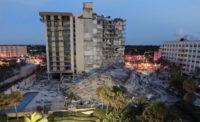...high-rise footprint (see slide 7). There, the lack of post-tensioning would create an uneven condition during an implosion. “If I get asymmetrical failure in garage columns surrounding the tower, it will cause the tower to skew out of the design path as it falls,” says Loizeaux.
To prevent this, CDI plans to equalize the condition by using explosives at the outset of the implosion to eliminate the post-tensioning on the opposite side of the garage before bringing the rest of the high-rise down.
Another headache, still unresolved, is how to handle the shores, highly engineered aluminum-alloy posts, installed to replace failed columns and beams. One idea is to put charges against the shores backed up with sandbags. Then, CDI would kick the shores out in concert with the tower implosion sequence. There are also 14-in.-deep H columns, in structural steel, under two failed tower columns. For this, CDI is considering using linear-shaped charges that would cut the steel during the implosion.
CDI decided to install cabling in the tower to provide structural integrity to “confidently” move the structure toward the east before starting the vertical failure. In all, crews are stringing and tensioning more than 3,000 ft of cable.
Crews have finished conventional pre-demolition of a 200-ft x 106-ft section of the garage, where the tower is designed to land. The clean concrete debris will act in concert with the exposed pile caps and piling to help direct debris impact energy at grade through the piling. That will reduce the energy available for a damaging surface wave, says Loizeaux.
CDI, which does not need permits for the implosion, has been in contact with the area’s various regulatory agencies. “CDI is worried about anybody entering the implosion zone,” says Javier Ch. Garza, South Padre Island’s interim chief of police who is coordinating security for the event. The biggest concern is pleasure boats filled with spectators, he says.



















Post a comment to this article
Report Abusive Comment